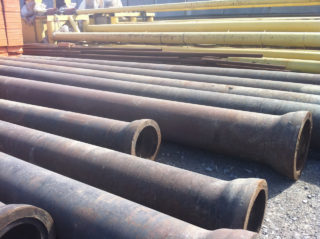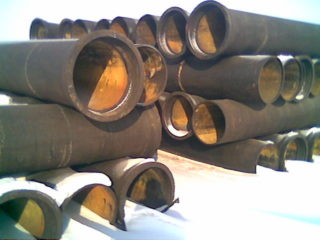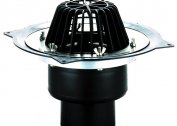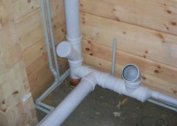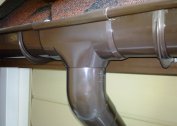Cast iron pipes are still being produced, although the market is gradually gaining plastic. Cast iron has properties that no synthetic lightweight material has, especially if new alloying technologies of pure cast iron are used in the manufacturing process. Such methods can increase strength, the degree of shrinkage, and the treatment of the inner surface with various compositions increases the service life and reduces the susceptibility to corrosion.
Application area
Cast iron is an alloy of iron and carbon. The percentage of carbon in the mixture is 2.14%. It is presented in the form of graphite or cementite - a carbon-containing substance. There is a white and gray alloy. White is an additional substance in the production of malleable cast iron, which is not used in its pure form due to its fragility.
Gray alloy has a large scope. On its basis, malleable, high-strength and specialized alloys are produced:
- high-strength cast iron is made using magnesium, the ductility of this substance is low;
- malleable alloy is made on the basis of gray cast iron with the addition of white, as a result of which a substance of soft consistency with a high coefficient of elasticity is obtained;
- half cast iron is a type of alloy in which part of the carbon is in the form of graphite, and part in the form of cementite.
If you compare cast iron pipes to steel pipes, the former will be more fragile, since graphite atoms do not tightly bond with iron atoms. Despite this, the material has its advantages, which allow it to be used in the following industries:
- In mechanical engineering, for example, in the manufacture of brake pads for cars.
- For the production of heating batteries that hold temperature well and for a long time and save coolants.
- In the production of pipes for indoor and outdoor sewage. Cast iron tolerates low temperatures well and does not lose its qualities.
- For the manufacture of plumbing fixtures - bathtubs, sinks, as well as works of art - fountains, monuments, sculptures.
In its structure, the alloy is a metal cavity in which graphite is enclosed. Depending on the variety, graphite inclusions can be spherical, plastic, flocculent or vermicular. Ultimately, the quality of the alloy depends on this.
Specifications
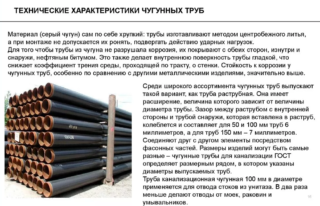 The characteristics of the metal are more dependent on the proportions of graphite and its varieties. In technical properties, cast iron sewer pipes compete with plastic, and sometimes surpass them. This applies to the degree of shrinkage and tension. If the internal sewage system can be made of plastic without sacrificing quality, then the external, and even more so city highway, should be made of more stable and durable material.
The characteristics of the metal are more dependent on the proportions of graphite and its varieties. In technical properties, cast iron sewer pipes compete with plastic, and sometimes surpass them. This applies to the degree of shrinkage and tension. If the internal sewage system can be made of plastic without sacrificing quality, then the external, and even more so city highway, should be made of more stable and durable material.
Cast-iron pipes are used for plumbing communications and sewerage. The environmental friendliness of cast iron is the highest - this material does not emit harmful substances into the water either during heating or during cooling. Additional processing from the inside prevents siltation of the pipe, so bacteria do not multiply.
In addition, the material has the following characteristics:
- high level of noise absorption;
- fire safety;
- the service life with proper care is about 100 years;
- slightly stretched when heated;
- resistance to chemically aggressive substances.
The alloy is not afraid of ultraviolet rays, therefore, sewers or other highways can be laid on the ground surface. Resistance to various vibrations makes it possible to lay the pipeline in places with heavy traffic without risk of damage to the pipe.
Advantages and disadvantages of cast iron sewer pipes
In the sewage system, an important role is played by the resistance of cast-iron pipes to aggressive liquids. So that the sediment does not accumulate inside, the line is periodically cleaned with acids. Resistant inner coating helps maintain a smooth inner surface. Currently, such a disadvantage as scoring and roughness is completely eliminated using modern casting methods, as well as the use of additional coating materials.
Seamless casting of cast iron pipes improves strength, and various additives of magnesium, manganese, silicon, and sulfur make it possible to achieve a qualitatively new material.
If a crack has formed in the cast iron product, it can be repaired with your own hands without resorting to the services of professionals. The wall thickness absorbs well all the noise associated with the passage of water or sewage through pipes. Thanks to this, products can be used for arranging internal wiring.
Of the disadvantages are especially significant:
- Fragility. Inaccurate loading or unloading, as well as falling, the product may burst.
- Relatively large weight, which does not allow to carry out construction work without the use of heavy equipment.
- The difficulty of connecting the two parts of the pipeline with a durable seam. To do this, use a special type of welding or use couplings with steel clamps.
- Installation of cast iron wiring takes much more time than plastic.
- The insert must be made by a master with experience in handling this alloy. Otherwise, the pipe may burst due to mechanical impact by percussion instruments.
- The price per meter of pig-iron sewer pipe is higher than a meter of plastic, which leads to an increase in the cost of the entire water supply or sewage system on the site.
Replacing a part of a cast-iron pipe with a plastic one can cause many problems. Sidebar must be trusted by professional workers.
Varieties of cast iron pipes
All pipes made of cast iron alloy are divided into pressure and pressureless. Pressure products practically exclude the appearance of cracks, and their characteristics are akin to high-carbon steel. They are used to supply drinking water or transport waste under pressure.
Home autonomous sewer systems or small office buildings use pressureless bell-shaped products. The socket facilitates installation - at one end there is an extension into which the socketless end of the other pipe is inserted. Such products should not be subjected to excessive load from the inside, as they are made of a less durable alloy. Plus pressureless pipes in their cost.
All products are manufactured with a bell, but in agreement with the customer can be made without expansion. In this case, they must be connected with stainless steel clamps to ensure tightness and to prevent premature corrosion. If socketless products are used in pressure sewers, crimp cuffs with a rubber ring resistant to aggressive fluids are additionally mounted.
It is necessary to make sure that the pipeline does not sag, since its weight is very large, it can cause the collapse of the pipeline.
According to GOST, the following sizes are distinguished:
- for internal wiring in a house or apartment, diameter 50 and 100 mm;
- for an external home highway 150 - 200 mm;
- for street wiring from 250 to 2000 mm.
Standard length: 75, 100, 125, 200, 210, 220 cm.
Features of the installation of cast iron pipes
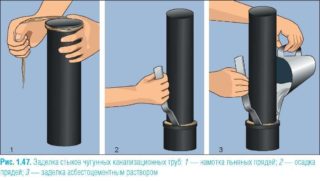 Mounting cast iron structures is the biggest challenge.In different situations, it may be necessary to connect the plastic to the old cast-iron pipe in the old building, to cut the steel pipe into the cast-iron or vice versa, to connect two cast-iron products - the new and the old.
Mounting cast iron structures is the biggest challenge.In different situations, it may be necessary to connect the plastic to the old cast-iron pipe in the old building, to cut the steel pipe into the cast-iron or vice versa, to connect two cast-iron products - the new and the old.
To facilitate the work, additional parts from the same material are used - fittings, turns, couplings, tees.
During installation are taken into account:
- freezing depth;
- bias;
- temperature in winter time - if necessary, the trunk is insulated;
- if possible, frequent turns of the pipeline should be avoided so as not to provoke blockage;
- the insert is made using a grinder.
Installation steps:
- The flat part is inserted into the bell.
- With the help of a soft hammer - wooden or rubber - the hole is sealed with tow.
- A cement mortar is poured on top of the tow.
Until the joints solidify completely, supports are placed under the pipeline.
If necessary, the organization of turns uses parts of the same brand as the main highway. In the case of replacing parts of a cast iron pipe with a new one, the age of the sewer is taken into account. Until 1974, there were other sizes in accordance with GOST, so the diameter of the purchased parts may not correspond to the available pipe diameter. In this case, adapters and gaskets are needed to ensure the tightness of the structure.
Lime deposits accumulate on the inner walls over time. Deposits of iron oxide often stick to water pipes, so it is necessary to combine such parts with rubber inserts and rags soaked in sealant.
To dismantle part of the highway, a grinder is used. It is advisable to saw the pipe to a bell so that it is convenient to attach a new part. Otherwise, you will have to pay for cuffs, couplings or fittings to ensure tightness.
The cost of cast iron products depends on the length, wall thickness, diameter and method of alloy production. The most expensive but durable is ductile iron. Strong pressure structures are made from it, so the total price of a home sewage system together with work can cost three times more than plastic. Cheaper to buy pressureless pipes. For autonomous private sewage, this is a profitable solution, based on the service life and versatility of the material.
